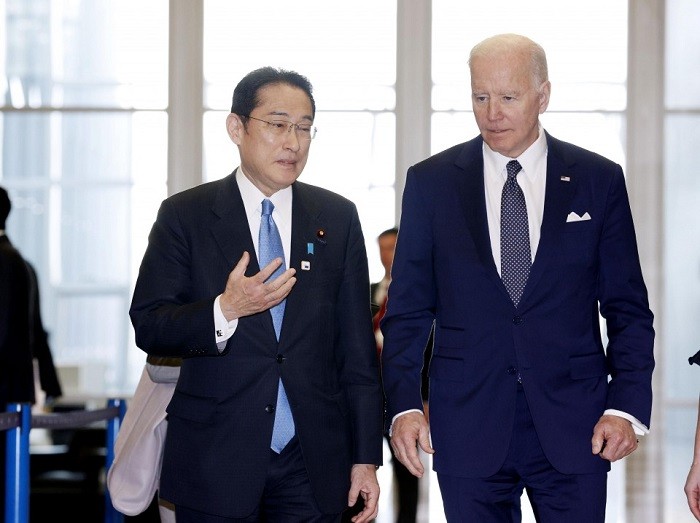
A warm welcome was given to Japanese Prime Minister Fumio Kishida during his first official visit on January 13 to the White House where US President Joe Biden hailed Tokyo’s newly launched defence policy, National Security Strategy while sharing his concern on rising militaristic aggression by China in the Indo-Pacific region. The Kishida-Biden meeting took place just two-day after the two countries held their two-plus-two ministerial dialogue in Washington DC.
At the dialogue, the two countries agreed to extend their security cooperation to space. Under this alliance they agreed that an attack against either side “to, from or within space” could trigger Article V of the two countries’ mutual security pact. Article V of the Japan-US security pact “recognises that an armed attack against either party in the territories under the administration of Japan would be dangerous to its own peace and safety and declares that it would act to meet the common danger in accordance with its constitutional provisions and processes.”
As per The Japan Times, during the two-plus-two dialogue, the two countries also agreed to enhance security coordination and deploy US’s revamped marine unit in Okinawa prefecture, lying in Japan’s southwestern territory. Yonaguni, a part of Okinawa prefecture is located 110 km from Taiwan and is close to the Diaoyu Islands which is claimed by Beijing but administered by Tokyo as Senkakus. Last year in August, Okinawa prefecture’s Yonaguni island was in the news as six Chinese missiles had fallen just outside the island’s shores, in waters Japan considers to be within exclusive economic zone.
In the recent past, China has increased its militaristic activities against Taiwan and a Chinese aircraft carrier and several other warships sailed into Western Pacific past the Japanese territory in December. China’s Liaoning aircraft carrier and five missile destroyers sailed past Japan’s Okinawa and Miyakojima islands, compelling Japan to scramble jet fighters and dispatch aircraft and warships in the Western Pacific area on December 16.
This was the second such incident of Chinese warships’ foray into the Western Pacific area since May, 2022. And, all this took place amidst China’s unstopped military aggression against Taiwan. On December 25, when the world was celebrating Christmas, China sent 47 aircraft across the median line of the Taiwan Strait. It was the largest incursion into Taiwan’s air defence zone in recent months. China has stepped up military activity against the self-ruling island since the visit of US House Speaker Nancy Pelosi in early August. On December 21, as per the US’ Indo-Pacific Command, a Chinese Navy J-11 fighter flew dangerously within six metres of a US Air Force RC-135 aircraft over the South China Sea. To avoid the collision, the pilot of the US jet had to take evasive manoeuvres, the US military said.
On January 8, the airborne brigade of the Japanese Self Defence Force conducted its first parachute drop drill along with paratrooper units from the US, British and Australian armies in Japan’s Chiba prefecture. This military exercise was held on the back of large-scale joint drills between the Japanese Self-Defence Forces and the US military in Japan’s Tokunoshima Island in Kagoshima Prefecture. In the military drill, held from November 10 to November 19, around 26,000 personnel from Japan’s ground, maritime and self-defence forces and about 10,000 US troops, including from the Space Force had participated. Military personnel from Australia, Canada and Britain had also joined the military exercise which was called “Keen Sword.” The exercise, as per the South China Morning Post, was carried out keeping China in mind.
Such moves hint towards Japan and the US’s eagerness to pull their socks up in the face of mounting challenges from Beijing which has a plan to invade Taiwan in 2026. As per a study by the US-based Centre for Strategic and International Studies, a possible invasion of Taiwan by China would lead to a major conflict wherein the US and Japan would lose dozens of ships, hundreds of aircraft, and thousands of servicemen. In most scenarios, the US Navy would lose two aircraft carriers and 10 to 20 large surface combatants.
The think tank said that China’s war against Taiwan may last for three weeks in which approximately 3,200 US troops would be killed, nearly half of what the US lost in two decades in conflict in Iraq and Afghanistan. The CSIS said Japan may lose more than 100 fighter aircraft and 26 warships in a possible Taiwan war in which China, as per the prestigious US think tank, would suffer heavily. The think tank’s prediction is that in the possible Taiwan war, China would lose 155 combat aircraft and 138 major ships while witnessing 10,000 PLA troops’ death. It further said tens of thousands of Chinese soldiers would be prisoners of war in the battle which would prove infructuous for Beijing.
Whether it happens or not, the Pentagon’s China Military Power Report prepared last year maintains that the PLA has increased “provocative and destabilising actions in and around the Taiwan Strait.” The report further said China’s these provocative and destabilising actions include “increased flights into Taiwan’s claimed air defense identification zone and conducting exercises” focussing on “the potential seizure of one of Taiwan’s outlying islands.”
Speaking about Taiwan at the 20th National Congress of the Chinese Communist Party in October last year, President Xi Jinping said China would strive for peaceful reunification but “we will never promise to renounce the use of force and we reserve the option of taking all measures necessary.” This has generated a widespread fear about China’s design in the Indo-Pacific region which has turned into a zone of heightened military and geopolitical activities in the recent past.
–The writer is a senior journalist with wide experience in covering international affairs. The views expressed are of the writer and do not necessarily reflect the views of Raksha Anirveda








